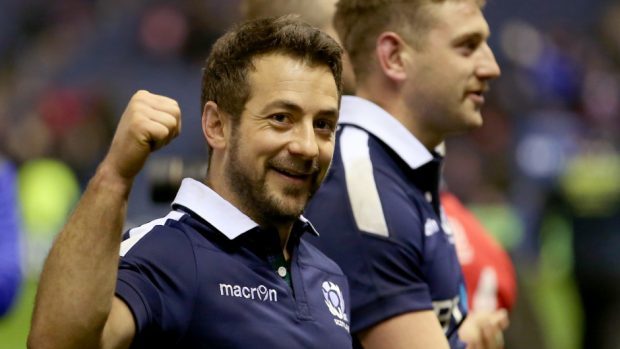If it’s the start of February, it must be just a few days until the beginning of another Six Nations Championship.
And, even for those many Scottish rugby fans, who have grown inured to defeat and disappointment, there are genuine reasons to be cheerful in the build-up to the 2017 hostilities.
After all, the Scots were impressive in their autumn internationals, where they beat Argentina, trounced Georgia and came agonisingly close to upsetting Australia. Glasgow, all bristling belligerence and breathless brio have qualified for the quarter-finals of the European Cup for the first time with a ruthless 42-0 pummelling of Leicester – and at Welford Road, which was once a bastion of Midlands machismo.
In what is New Zealand coach Vern Cotter’s last campaign before handing over the reins to Gregor Townsend, there does seem to be a seismic shift away from the pattern of recent tournaments.
Too often, it has been a joust between the Scots and Italians for the unwanted wooden spoon and a hapless stroll down the Via Dolorosa for the vanquished.
But Wales were awful during their autumn skirmishes, a shadow of where they were on the international stage five years ago; Italy have been so one-dimensional and predictable at Test level that you could legitimately ask what they’ve brought to the event beyond nice winter trips to Milan and Rome for fans and committee members: and France have fallen so dramatically between two stools and styles, without remotely merging pragmatism with panache to any positive conclusion, that Les Bleus are in danger of relinquishing all their old qualities.
In that light, and despite being far from a happy-clappy optimist when it comes to sport, I genuinely fancy the Scots’ chances in the next couple of months when they lock horns with Ireland, Wales and Italy at home and England and France away.
Cotter’s squad isn’t just powerful, it is versatile and there is plenty of competition for places in most positions.
The redoubtable Greig Laidlaw will never rival Piers Morgan in the prima donna stakes, but he has the look of a man who knows the SRU’s finest are striding forward. And he thinks this is the strongest group with which he has been involved.
Granted, the reigning Grand Slam champions, England, will begin as favourites and it’s daunting to think that Scotland haven’t tasted victory at Twickenham since 1983, but just consider the options available to Cotter, whose personnel launch their bid against Ireland on Saturday.
Their backline sizzles with menace, shock and awe, from Stuart Hogg and Sean Maitland to Matt Scott, Mark Bennett, Duncan Taylor, Tim Visser and Tommy Seymour among some of the Northern Hemisphere’s most efficacious three-quarters and such irrepressible performers as Laidlaw, Finn Russell, Henry Pyrgos and Duncan Weir at half-back.
Better still, whereas once the Scottish scrum was prone to buckle against heavy-artillery opponents, they can now fight fire for fire in the front and second rows and boast a near embarrassment of riches in their back row.
As Ben Toolis, no slouch himself, said last week: “The second row is difficult to crack. Jonny and Richie Gray always play well for Scotland, and you’ve got Gilko [Grant Gilchrist] as well. It’s very tough.
“Every member of the squad could start and do a good job. That’s probably where we’ve been lacking in the past. We’ve always had a pretty good one to 15, but if there’s an injury, people may fill the role, but not necessarily do it as well. Whereas now, it’s the best I’ve seen.”
It never does for the Murrayfield faithful to be over-confident, especially given the team’s lacklustre results in the competition since the Five became Six in 2000. Indeed, the significance of the opening tussle can hardly be overstated and the stark reality is that the Scots have not triumphed in their first match since 2006 when they overcame France by 20-16 with a brace of tries from Sean Lamont and the remainder of the points from Chris Paterson’s boot.
And they could hardly have asked for a sterner induction than against the Irish, who famously recorded their first-ever victory over New Zealand in Chicago and followed it up with wins against Australia and South Africa.
Yet, where once that might have prompted apprehension and anxiety for the hosts in Edinburgh, one suspects they have battened down myriad physical and psychological hatches in the last 12-18 months.
As Gary Armstrong, the captain of the side which surged to success in the last Five Nations Championship 18 years ago, declared: “You can’t overestimate getting up and running in the opener.
“Suddenly, you have momentum, the supporters get excited, and the games come thick and fast. We’re at home this time and it will be a hard test, but I’ve been impressed by Vern’s boys.
“It doesn’t matter how they win as long as they win. If they beat Ireland, they can go to Paris with a real belief and a spring in their step the week afterwards, and both the pro teams have shown recently they don’t fear these kind of matches any more.”
There have been too many false dawns for anybody to be complacent. And, for all that Cotter’s charges came close against the Wallabies in November, they couldn’t quite edge over the line, where England and Ireland achieved that notable feat.
But I think the Scots can secure three victories and possibly four if they explode out of the starting blocks. They won’t meet England until the penultimate round of the tournament, but when you look into the eyes of Cotter and Laidlaw and examine the no-holds-barred aggression of the Grays and John Hardie, you can discern a steely resolve to exorcise the demons of the past.
It promises to be a thrilling journey. And, as somebody who watched Armstrong and his confreres score five tries during an incredible first half at the Stade de France in 1999, it could be a very auspicious one.
Bring it on!
